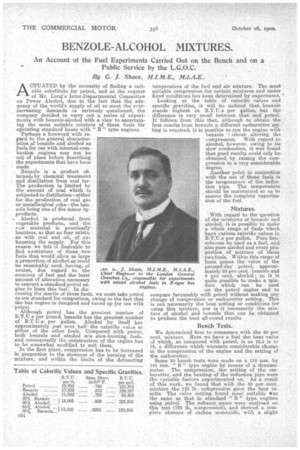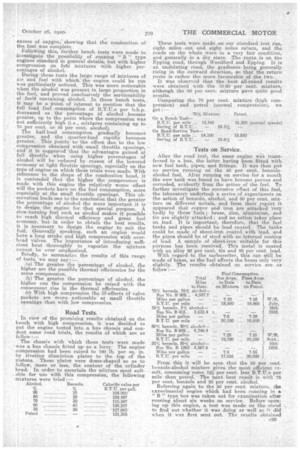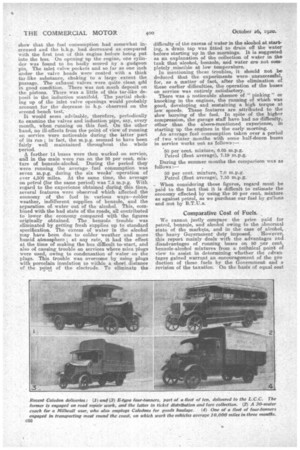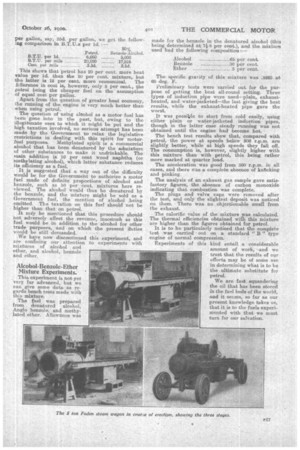BENZOLE-ALCOHOL MIXTURES.
Page 20

Page 21

Page 22

Page 23

If you've noticed an error in this article please click here to report it so we can fix it.
An Account of the Fuel Experiments Carried Out on the Bench and on a Public Service by the L.G.O.C.'
By C. J. Shave, M.I.M.E., M.I.A.E..
ACTUATED by the necessity of finding a suitable substitute for petrol, and at the request of Mr. Long's Inter-Departmental Committee en Power Alcohol, due to the fact that the adequacy of the world's supply of: oil to meet the ever increasing demands is seriously questioned, the company decided to carry out a series of experiments with benzole-alcohol with a view to ascertaining the most suitable mixture of these fuels for operating standard buses with " B " type engines.
Perhaps a foreword with re pad to the general eharacter'sties of benzoic and alcohol as fuels for use with internal-combustion engines may not be out of Place before describing the experiments that have been made.
. BenzoIe is a product obtainedt by chemical treatment and distillation from coal tar.
The production is limited by the amount of coal which is subjected to distillation—either for the production of coal gas or metallurgical coke—the bensole being one of the minor byproducts. . Alcohol is produced. from vegetable products, and the raw material ie practically limitless, so that no fear exists, as with coal and oil, of ex hausting the supply. For this reason we felt it desirable to find aomixture of these two fuels that would allow as large a proportion of 'alcohol as could be reasonably used, having, of course, due regard to the economy of fuel and the, least amount of alteration necessary to convert a standard petrol en gine to Jai= this fuel. In dis cussing the merits of these fuel, we must take petrol as our standard for comparisan, owing to the fact that the bus engine is designed and tuned-up for use with petrol.
Although petrol has the greatest 'number of B.T.U.s per pound, benzole has the greatest number of B.T.U.s per gallon. Alcohol by itself has approximately just over half the calorific vaLe oi either of the other fuels. Compared with petrol, both benzole and alcohol are slow-burning fuels, and consequently the construction of the engine has to be somewhat modified to suit them. In the first place, compression has to be increased in proportion to the slowness of the burning of the mixture, and within the limits of the detonating temperature of the fuel and. air mixture. The most suitable compression for certain mixtures and under fixed conditions has been determined by experiment.
Looking at the table of calorific values and specific gravities, it will be noticed that benzoic stands highest in B.T.U.s per gallon, but the difference is very small between that and petrol. It follows from this that, although to obtain the best results from laenzole a different carburetter setting is required, it is possible to run the engine with benzole ithout altering the compression. With regard to alcohol, however. owing to its slow combustion, it was found that good results could only be obtained by raising the compression to a very considerable degree.
Anotherpoint in connection with the use of these fuels is the temperature of the induction pipe. The temperature should be niaintained so as to ensure the complete vaporization of the fuel.
Mixtures.
With regard to the question. of the mixtures of benzole and alcohol, it is possible to make a whole range of fuels which• have various calorific values in B.T.`U.s per gallon. Pure benzole.eari be used as a fuel, and, also pure alcohol and every proportion of mixture of these two fuels. Within this range of fuels comes the value of the present-day petrol, approximately 92 per cent. benzole and 8 per cent, alcohol ; so it is quite possible to make a mixture which can be used on the petrol engine and to compare favourably with petrol without making any change of compression or earburetter setting. This is not. necessarily the hest setting or conditions for using this mixture, nor is it necessarily the mixture of alcohol and b.enzale that can be obtained to produce the best all-round.results
Bench Tests. •
We determined first to commence with the 50 per cent. mixture. Here we have a fuel the heat value of which, as compared with petrol, is as 12.5 is to 15, a difference which warrants considerable change in the compression of the engine and the setting of the carburetter.
Some 50 'bench tests were made on a 110 mm. by 140 rim. " B " type engine by means of a dynamometer. The compression, the setting of the carburetter, and the heating of the induction pipe were the variable factors experimented on. As a result of this work, we found that with the 50 per cent. mixture the 123 lb. catopression gave the best results. The valve setting found most suitable *as the same as that in standard " B " type engines using petrol. The exhaust gases were analysed on this test (1-23 lb, compression), and showed a, complete absence of carbon monoxide, with a slight
excess of oxygen, showing that the combustion of the fuel was complete. Following this, further bench tests were made to investigate the possibility of running "B " type engines standard in general details, but with higher compression on fuU mixtures with higher percentages of alcohol.
During these tests the large range of mixtures of air and fuel with whichthe engine could be run was particularly noticed. This was more noticeable -when the alcohol was present in large proportion in the fuel, and proved conclusively the serviceability of fuel containing alcohol. In these bench tests, it may be a point of interest to mention that the full load fuel consumption of B.T.U.s per b.h.p. decreased as the percentage Of alcohol became greater, up to the point where the compression was not sufficiently high (i.e., mix-tares containing up to 70 per cent. or80 per cent. alcohol). The half-load consumption gradually becomes greater, and the quarter-load rapidly becomes greater. This points to the effect dueto the low compression obtained with -small throttle openings, and it is suggested 'that the advantages gained at full throttle' when using higher percentages of alcohol will be reduced by reason of the lowered economy at light throttle openings, especially on the type of engine on which these trials were made. With reference to the shape of the combustion head, it is contended that the higher the compression is made 'with this engine -the relatively worse effect will the pockets have on the fuel consumption, more especially at the small throttle openings. This observation leads one to the conclusion that the greater the percentage of alcohol the more important it is to design the engine for that special purpose. A slow-burning fuel such as alcohol makes it possible to reach high thermal efficiency and great fuel economy.but in order to obtain the best results, it is necessary to design the engine' to suit the fuel. Generally speaking, such an engine would have a long stroke and high compression with overhead valves. The importance of introducing sufficient heat thoroughly to vaporize the mixture cannot be over emphasized.
13riefly, to summarize the results of this range of tests, we may say :----, (a) The greater the percentage of alcohol, the higher are the possible thermal efficiencies for the same compression.
(b) The greater the percentage of alcohol, the higher can the compression be raised with the consequent rise in the thermal efficiencies.
(e) With high compression the ill-effects of valve pockets are more noticeable at small throttle openings than with low compression.
Road Tests.
In view of the promising results obtained on the bench with high compression, it was decided to put the engine tested into a bus chassis and conduct some road trials, the results of which are as foil : —
The chassis with which these tests were made was a bus chassis fitted up -as a lorry. The engine compression had been raised to 160 lb. 'per sq. in, by riveting aluminium plates to the top of the Pistons. These plates were dome-shaped so as to follow, More or less, the contour of the, cylinder bead. In order to ascertain the mixture most suitable for use with this compression, the following mixtures were tried: --
Alcohol, Benzole. Calorific value per B.T.U. per gall. 90 10 104,000 80 20 109,487 70 30 115.347
60 40 120,207 50 50 -127,063
Petrol 151,305
These tests were made on our standard test run, eight miles out and eight miles return, and the roads on the whole were in a very fair condition, and generally in a dry state. The route is on the Epping road, through Woodford and Epping. It is an undulating road, the gradients being generally rising in the outward direction, so that the return route is rather the more favourable of the two.
It was observed :that the best all-round results were obtained with the 70-30. Per cent. mixture, although the 50 per cent. mixture gave quite good results.
Comparing the 70 per cent. mixture (high coinpresSion) and petrol (normal compre'ss.ion), we get 70% Mixture. • Petrol.
On a Bench TeSt B.T.U. per mile ... 12,160 16,100 (normal speeds) Saving of B.T.U... — 24.5% — On Road-Service Test
B.T.U. per mile 14,100 15,810
Saving ,of B.T.U... — ,10.8% — •
Tests on Service.
new fuel tank, pipes, and fittings. It was then put ferred to a bus, the latter having been fitted with the new tank -was found to have become porous and . further investigate the corrosive effect of this fuel, the laboratory -undertook a Series of experiments on the action of benzole, alcohol, and 50 per cent. mixture on different metals, and from their report it badly by these 'fuels; brass, zinc, aluminium, and on service running on the 50 per cent. benzolealcohol fuel. After running on service for a month corroded, evidently from the action of the fuel. To appeared that copper and iron are attacked 'Very tin are slightly attacked ; and no action takes place tanks and pipes should be lead coated. The tanks could be made of sheet-iron coated with lead, and on lead. It is important, therefore, that the fuel After the road test, the same -engine was transthe pipes should be of steel with an inteinal coating a lead. A sample of sheet-iron suitable for this purpose has been received. This metal, is coated with an alloy 20 per cent. tin and 80 per cent, lead. With regard to the carburetter, this can still be made of brass, a-s the fuel affects the brass only very The results obtained on service. are as follow :— Fuel Consumption.
Total Bus Avge. Fleet Avge Miles. to Date to Date , to Dale. on Mixture. on Petrol.
75% benzole, 25% alcohol— • 1 Bus No. B 908... 4,597.7 ... — 7758 Milos per gallon — ... 7.42 ...
B.T.U. per mile — ... 18,980 ... 19,900 95% benzole, 5% alcohol—
Bus No. B 415... 2,632.4 1... — — Miles per gallon — 7.6 7.58 B.T.U. per mile — 20,150 19,900
80% benzoic, 20% alcohol—
Bus No. B 840... 6.746.4 — — Mile; per gallon — 7.28 7.55
B . T.U. per mile — 19.780 20,050 50% benzole, 50%, alcohol—
Bus No. B 1263 4,567.6 — 7155 Miles -per gallon — 7.0 20,050 j B.T.U. per mile — 17,816
From this it will be. seen that the 50 per cent. benzole-alcohol mixture gives the most efficient result, consuming some 121 per cent. less B.T.U.s per mile than petrol. The next best result is with 75 per cent. benzole and 25 per cent. alcohol. Referring a-gain to the 50 per cent. mixture, the experimental engine which had been running in a " B " type bug was taken out for examination after running about six weeks on service-. Before opening up this engine, a test was made on the, stand to find out whether it was doing as well as it did when it was first sent out. The results obtained show that the fuel consumption had somewhat increased and the b.h.p. had decreased as compared with the first test of this engine before being put into the bus. On opening up the engine, one cylinder was found to be badly scored by a gudgeon pin. The inlet valve pookets and so far as one inch under the valve heads were coated with a thick ten like substance choking to a large extent the passage. The exhaust valves were quite clean add in good condition. There was not much deposit on the pistons. There was a little of this tar-like deposit in the induction manifold. The partial choking up of the inlet valve openings would probably account for the' decrease in h.p. observed on the second bench test.
It would seem advisable, therefore, periodically to examine the -valves and induction pipe, say, every month, when. running on this fuel. On the other hand, no ill-effects from the point of view of running . on service were noticeable during the latter' part of its run ; in fact, the m.p.g. seemed to have been fairly well maintained throughout the whole period.
A further 14 buses were then worked on service, aria in the main were rim on the 50 per cent, mixture of benzote-alcohol. During the period they were running the average fuel consumption was seven m.p.g. during the six weeks' operation of over 4,500 miles. At the same time, the average on petrol (for the same period) was 7.5 m.p.g. With regard to the experience obtained during this time, several features were observed which affected the economy of the fuel in various ways—colder weather, indifferent. supplies of benzole, and the separation of, water out of the alcehol. This, combined with the bad state of the roads, all contributed to lower The economy compared wi,th the figures originally obtained. The. benzoic, trouble was eliminated by getting fresh, supplies up to standard specification. The excess of water in the alcohol may have been due to colder weather and more humid atmosphere • at any rate., it had the effect at the time of making the bus difficult to:start, and also of causing trouble on services where mica plugs were used, owing to condensation of water on the plugs. This trouble was overcome by using plugs with porcelain insulation' to within a short, distance of the point of the electrode. To eliminate the
difficulty of the excess of water in the aleohol at start•ing, a drain tap was fitted to drain off the water before starting up in the mornings. It is suggested as an explanation of the collection of water in the tank that -alcohol, berizole, and water are not completely _miscible at low temperature.
In mentioning these troubles, it should not be deduced that the experiments ware unsuccessful, for, as a matter of fact, after the elimination of these earlier difficulties, the operation of the buses on service was entirely satisfactory.
There was a noticeable absence of " pinking" or knocking in the engines, the running of which was good, developing and sustaining a high torque at low speeds. These features are attributed to the slow burning of the fuel. In spite of the higher compression, the garage staff have had no difficulty, other than the above-mentioned experience, in starting up the engines in the early morning. An average fuel consumption taken over a period of two winter months with some half-dozen buses in service works out as follows: 50 per cent. mixture, 6.05 m.p.g. Petrol (fleet average), 7.19 m.p.g.
During the sun-truer months the comparison was as follows :
50 per cent. mixture, 7.0 m.p.g. Petrol (fleet average), 7.55 m.p.g.
. When considering these figures, regard must be paid to the fact that it is difficult to estimate the economy effected by using the 50 per cent,. mixture as against petrol, as we purchase our fuel by gallons and not by B.T.U.s.
Comparative Cost of Fuels.
We cannot justly compare the price paid for petrol, benzoie, and alcohol owing to the abnormal state of the markets, and in the case of alcohol, the heavy Government duty imposed. . However, this report mainly deals with the advantages and disadvantages of running buses on 50 per cent. benzolealcohol mixtures from a teehnical point of view to assist in determining whether the advantages gained warrant an encouragement of the pro duction of these fuels by the Government and a revision of the taxation. On the basis of equal cost per gallon, say, 25d. per gallon, we get the following comparison in B.T.U.s per id.
50% Petrol. Benz°le-Alcohol.
B.T.U. per 1d. 6,050 5,000 B.T.U. per mile 20,050 17,816
Cost per mile 3.5d.
This shows that petrol has 20 per cent. more heat value per ld than she 50 per cent, mixture, but the latter is 12 per cent, more economical. The lifference in cost is, however, only 5 per cent., the petrol being the cheaper fuel on the assumption of equal cost per gallon.
Apart from the question of greater heat economy, the running of the engine is very much better than when using petrol. The question of using alcohol as .a motor fuel has been gone into in the past, but, owing to the illegitimate uses to which it might be put and the high taxation involved, no serious attempt has been made by the Government to relax the legislative restrictions in dealing with this spirit for motor-. fuel purposes. Methylated spirit is a commercial alcohol that has been denatured by the admixture of other substances to make it undrinkable. The main addition is 10 per cent wood naphtha (or methylating alcohol), which latter substance reduces its efficiency as a, fuel.
It is suggested that a way out of the difficulty would be for the Government to authorize a motor fuel made of definite proportions of alcohol and benzole, such as 50 per cent, mixtures here reviewed. The alcohol would thus be denatured by the benzole, and the mixture might be sold as a Government fuel, the mention of alcohol .being omitted. Tho taxation on this fuel should not be higher than that on petrol. , It rmfy be mentioned that this procedure should not adversely affect the revenue, insomuch as this fuel would be in addition to the alcohol for other trade purposes, and on which the present -duties would be still demanded.
We have now discontinued this experiment, and are confining our attention to experiments with mixtures of alcohol and ether, and alcohol, benzole and ether. made for the benzoic in the denatured alcohol (this being determined at 1-8 per cent.), and the mixture used had the following composition:— Alcohol 65 per cent.
Benzole 30 per cent. Ether 5 per cent.
The specific gravity of this mixture was :8265 at 60 deg. F.
Preliminary tests were carried out for the purpose of getting the best all-round setting. Three types of induction pipe were used—plain, exhaustheated, and water-jacketed—the last giving the best results, while the exhaust-heated pipe gave the worst.
It was possible to start from cold easily, using either plain or water-jacketed induction pipes, though in the latter ease steady running was not obtained until the engine had become hot.
The bench test results show that, compared with petrol, the power at speeds below 900 r.p.m. are slightly better, while at high speeds they fall off. The consumption is, however, slightly higher with this mixture than with petrol, this being rather more marked at quarter load. The acceleration was good from 360 r.p.m. in all cases, and there was a complete absence of knticking and pinking.
The analysis of an exhaust gas sample gave satisfactory figures, the absence of carbon monoxide indicating that combustion was complete. The plugs and valve caps were removed after the test, and only the slightest deposit was noticed on them. There was no objectionable smell from the exhaust.
The calorific value of the mixture was calculated. The thermal efficiencies obtained will this mixture are higher than the figures obtained for petrol. It is to be particularly noticed that the complete test was carried out on a standard " B " type engine of normal compression.
Experiments of this kind entail a considerable • amount a work, and we trust that the results of our efforts may be of some use in determining what is to be the ultimate substitute for petrol.
We are fast squandering the oil that has been stored in the fuel beds of the world, and it seems, so far as our, present knowledge takes us, that it is to the fuels experimented with that we must turn for our salvation.




























































